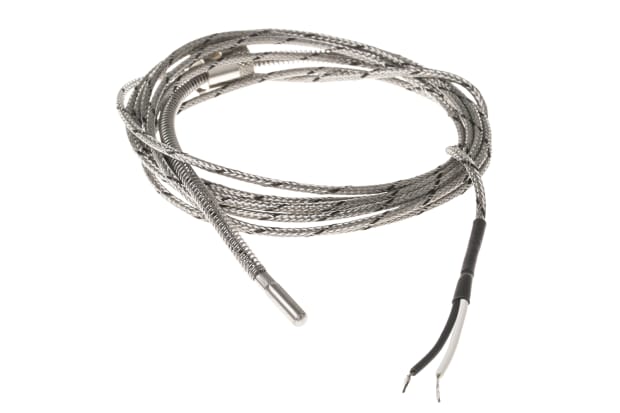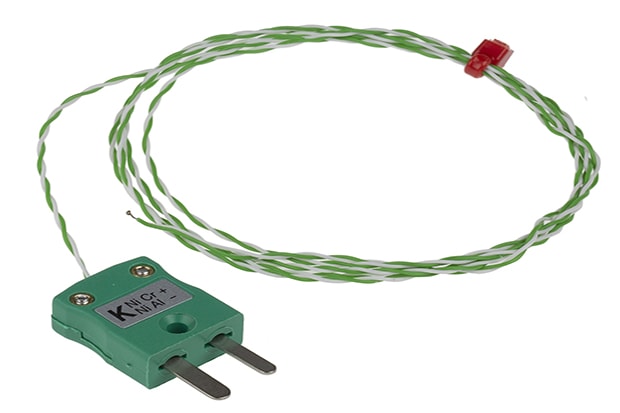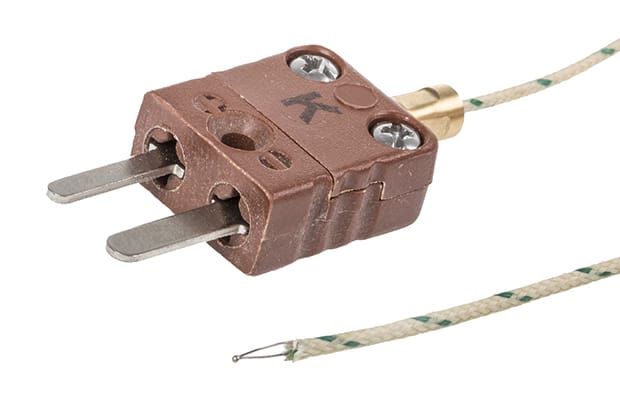- Published 5 Jan 2023
- Last Modified 17 Jun 2024
- 12 min
Everything You Need To Know About Thermocouples
Thermocouples are extremely useful and widely deployed temperature measurement tools, commonly found being used in a broad range of scientific, industrial and engineering environments.

Reviewed by Stephen Bettles, Technical Support Engineer (July 2021)
This guide is part of our Industrial Automation hub where you can discover more about AI, automation and control.
What is a thermocouple?

A thermocouple is a sensor tool that’s principally designed to measure the unknown temperatures of various physical bodies, components or substances.
Their small size and rapid response times mean they can be put to work in all manner of hazardous or challenging settings, while still providing the ability to swiftly and accurately measure extreme temperatures (anywhere in the range of 270 to 2,500 degrees Celsius, depending on their specific configuration).
Despite this impressive ability, they’re actually relatively simple tools that are both highly robust and extremely cost-effective. Different types of thermocouples, usually defined by letters such as J, K, L, N or T, offer different extremes of these key characteristics - some are designed using particular materials to withstand the highest temperatures and most challenging environments, while others are less rugged, cheaper to manufacture, and intended for use in less extreme environments. In this guide, we’ll take a closer look at the various sorts of thermocouples available on today’s market, and discuss some of their potential uses.
What does a thermocouple do?
As noted above, a thermocouple is a sensor tool that’s principally designed to measure the unknown temperatures of various physical bodies, components or substances.
Crucially, a thermocouple is made up of at least two wires of different metals that, when joined together to form a circuit, create two separate electrical junctions. One junction is located where an unknown temperature needs to be measured (the ‘hot’ or measuring junction), and one connected to a body of known and stable temperature (the ‘cold’ or reference junction).
The temperature differentials between these two junctions at any given time create voltage within the circuit, and the subsequent current flow can be used to measure the temperature at the unknown or ‘hot’ point of contact.
How does a thermocouple work?
A thermocouple works, perhaps unsurprisingly, on the basis of thermoelectrics: as noted above, when temperature changes at the hot junction relative to the cold junction, it creates a change in voltage across a closed circuit consisting of dissimilar metal wires.
For a very simple view of this principle in action, think about holding a one-piece frying pan over a gas burner. While it will quite quickly become apparent that heat travels up the handle towards the cold end in your hand, what’s less immediately obvious is that electricity is also making the same journey.
This happens precisely because of the difference in heat levels at the two ‘junctions’ on the circuit: current is created by electromotive forces generated by the temperature differential between each junction, and a thermocouple uses an attached voltmeter to measure that current. Provided it already knew the stable start temperature at the cold end, the thermocouple can use these voltage readings to calculate a precise temperature reading at the hot junction.
It’s worth noting, too, that if the temperature at both the junctions is the same, the electromotive forces generated at each junction will essentially cancel one another out - and the result will be that the net current flowing through the junction registers as zero.
What is the Seebeck effect?
In simple terms, the principle outlined above is what’s known as the Seebeck effect, after physicist Thomas Johann Seebeck. He was the first to discover that joining two different metals together at two junctions of differing temperatures produced an electromotive force and that this force would be different depending on the specific combination of metals in question.
Seebeck’s findings were further refined by at least two other physicists, including Peltier and Thomson, to the point where the precise voltage value registered in a circuit of different metals could subsequently be used - with the application of strict scientific formulae - to interpret a previously unknown temperature value.
As such, the workings of a modern thermocouple are reliant on a combination of at least three physicists’ observations, all of which stemmed initially from the discovery of the Seebeck effect.
What does a thermocouple look like?
Thermocouples can look physically very different to one another, depending on their intended application and work environment. But, as can be seen in the example of a thermocouple diagram below, they all rely on the same basic principles and systems:

Two or more dissimilar thermocouple wires form (at least) two junctions within a circuit, one of which is always kept at a steady and stable temperature - usually lower, but sometimes higher, than the temperature at the measuring (‘hot’) junction.
A voltmeter connected to the circuit reads the voltage created by electromotive forces as a result of temperature differential, and this can then be used to give a precise reading for the temperature at the measuring junction.
Types of thermocouples
As previously noted, there are various thermocouple types available on today’s market, all of which are designed to handle a different range of application scenarios or environmental challenges - and, in particular, different temperature ranges. They’re typically differentiated by letters: among the most commonly found grades of thermocouples are J, K, L, N and T.
Each of these letters tends to represent a different combination of metals used in the thermocouple circuit junctions. This will have a direct impact on the temperature sensitivity and safe operating range of the unit as a whole.
In this section of the guide, we’ll examine some of these different types and configurations of thermocouples to see what sorts of environments and temperature ranges they might typically be deployed in.
K type thermocouples
The most commonly used type in numerous industries and sectors. Type-K units are made from a combination of nickel-based wires (typically chromel/alumel), which results in an especially cost-effective thermocouple that tends to be accurate and reliable across a wide range of operating temperatures.
K-type thermocouples are generally used within ranges of -200 to +1260 celsius and are considered temperature accurate to a standard deviation of ±0.75%.
Type-K thermocouples have a wide range of potential applications due to being nickel-based, which means their wires are able to operate at a particularly wide range of temperatures and generally exhibit solid resistance to corrosion and oxidation.
Thermocouple wire in type-K specifications will generally include a positive leg made from roughly 90% nickel, 10% chromium, and a negative leg composed of around 95% nickel, 2% aluminium, 2% manganese and 1% silicon.
J type thermocouples
These are another widely used variety, although they will generally have a narrower temperature range (-40 to +750 Celsius) than K-types, and exhibit a shorter overall lifespan if regularly exposed to more excessive heat. The positive leg of a type-J unit is made from iron wire, and the negative leg will be composed of a copper-nickel (constantan) alloy.
It’s one of the least expensive thermocouple varieties, and is considered versatile, being especially well-suited to use in reducing (non-oxidising) atmospheres and vacuums, and is ideal for taking readings from many older types of equipment as well as inert materials. However, the iron components in J-type units are highly susceptible to oxidation, and should not be used in situations where they’re likely to be at risk of exposure to moisture of any kind.
N Type thermocouples
Consist of wires made from nicrosil-nisil alloys (nickel, chromium and silicon), and display many similar properties to those found in K-type thermocouples, with operating temperatures in the range of -270 to +1300 celsius.
However, they’re slightly more expensive than K varieties, owing to their more recent development in order to overcome certain issues with K-types in specific environments - in particular, the type-N offers better all-round stability in nuclear applications, and exhibits lower susceptibility to oxidation than K varieties under more extreme heat demands.
T type thermocouples
Temperature ranges run between −200 to +350 celsius, and it’s noted for being an especially stable thermocouple configuration, composed of copper-constantan alloy wires. This makes type-T thermocouples ideally suited to a variety of cryogenic and other extreme low-temperature applications, including a wide range of laboratory and similar deep-freeze conditions. It functions well in oxidising atmospheres too, and is frequently used for differential measurement due to the fact that only copper wires make direct contact with the probes. T-type thermocouples are also widely used in the food industry as linearity over 0-100c is good.
What are thermocouples used for?
As we’ve previously touched on, many different types and configurations of thermocouples are very widely used in an enormous array of everyday domestic and professional applications, including household appliances, industrial machinery, automotive mechanisms, laboratory settings and more.
Examples might include, to name just a few:
Thermocouples for thermostats
Thermostats in a plethora of settings very often include thermocouples as key components in their proper and efficient functioning. There is often some confusion about the exact differences between one and the other, due to their frequent proximity, closely related (but distinct) functions, and similar names.
Key to avoiding this mix-up is to remember that a thermocouple is a temperature sensor, and exists to provide a reading. A thermostat, on the other hand, is the part of the device that actually switches things on and off automatically based on that reading. As such, a thermocouple is often the component used in a thermostat whose reading triggers the thermostat to perform an on/off action.
Thermocouples for medical thermometers
Hospital grade thermometers and other forms of medical detection, diagnosis and treatment equipment often use a thermocouple. These are frequently configured in specialist or miniaturised versions, intended to help with faster and more accurate temperature readings of both patients and heat-critical machinery and processes.
Applications might include anything from skin sensors and hypodermic insertion to tumour detection and DNA research, temperature-related flow sensing and catheter probes. Many types of medical thermometers rely on thermocouple technologies for extremely precise measurement using very fine-gauge wires.
Thermocouples for vehicle diagnostics
Thermocouples are widely used in automotive and aerospace applications to help monitor and manage a wide range of important temperatures, covering everything from diagnostics to improved engine performance to vehicle safety.
Data read by engine thermocouples and other vehicular sensors can be used to monitor and adjust factors such as exhaust gas readings, cylinder head and spark plug function, disc brake performance, battery health and changes to external environments.
Thermocouples for boilers, heating sensors and ovens
Thermocouples for boilers, hot water systems, heating sensors and ovens work in much the same way as they would for a thermostat, as outlined above. Gas varieties of these appliances in particular often incorporate thermocouples as safety features, preventing gas valves from opening if the heat from a lit pilot light isn’t generating the required voltage across a thermocouple circuit.
When found in boilers and hot water systems, thermocouples are often referred to interchangeably with thermistors, although this isn’t strictly accurate. While both are used to measure temperature, a thermistor is a slightly different component that works on the basic principle that electrical resistance within materials change as the temperature rises and falls. Unlike a thermocouple, a boiler thermistor doesn’t actually generate a voltage.
Thermocouples for food thermometers, industrial probes and sensors
Food thermometers very often incorporate thermocouple technology to provide a very swift and accurate temperature reading, both at the manufacture and preparation stages of food ingredients and whole meals. Unlike a traditional catering thermometer, thermocouples aren’t intended to be left in the food during cooking.
The rapid response time of a thermocouple in, say, a digital food thermometer means it can be used to quickly and accurately relay precise temperatures at multiple locations on larger items, such as meat and poultry, without having to wait for the thermometer itself to register the correct heat reading in each spot.
Additionally, the fact that the technology can be downscaled to very small and accurate wire connections also makes it possible to get precise readings on thinner or more delicate items that wouldn’t stand up to a thicker-gauge standard food thermometer.
The same principles apply to a whole range of industrial-grade sensors and probes used in many different kinds of manufacturing and other temperature-critical production processes. Many of these thermocouples intended for a factory, mechanical or laboratory applications will also include features such as magnetic probes and more robust thermosensors in order to perform well in far more demanding environments than are typically required for most domestic uses.
International Thermocouple Colour Codes
Codes | Conductors | British | American | German | New |
|---|---|---|---|---|---|
E | Nickel Chromium / Constantan | Brown (+) Blue (-) | Pink (+) Red (-) | Purple (+) White (-) | |
J | Iron* / Constantan | Yellow (+) Blue (-) | White (+) Red (-) | Red (+) Blue (-) | Black (+) White (-) |
K | Nickel Chromium / Nickle* Aluminium | Brown (+) Blue (-) | Yellow (+) Red (-) | Red (+) Green (-) | Green (+) White (-) |
N | Nicrosil / Nisil | Orange (+) Blue (-) | Orange (+) Red (-) | Pink (+) White (-) | |
T | Copper / Constantan | White (+) Blue (-) | Black (+) Red (-) | Red (+) Brown (-) | Brown (+) White (-) |
RCA SCA | Copper / Copper-Nickel | White (+) Blue (-) | Black (+) Red (-) | Red (+) White (-) | Orange (+) White (-) |
KCB | Copper / Constantan (Low Nickle) | White (+) Blue (-) | Brown (+) Red (-) | Red (+) Green (-) | Green (+) White (-) |
*Magnetic
Please note that different alloys may be used in certain circumstances. These are distinguished by additional letters e.g. KCB.
Summary
As with all types of sensors and transducers, the best choice of thermocouple for the specific needs of the task you have in mind will be greatly influenced by the diverse range of available formats, materials, configurations and associated thermocouple costs available on today’s market.
Here are some of the best-selling brands – click through to see the wide range of products available:



